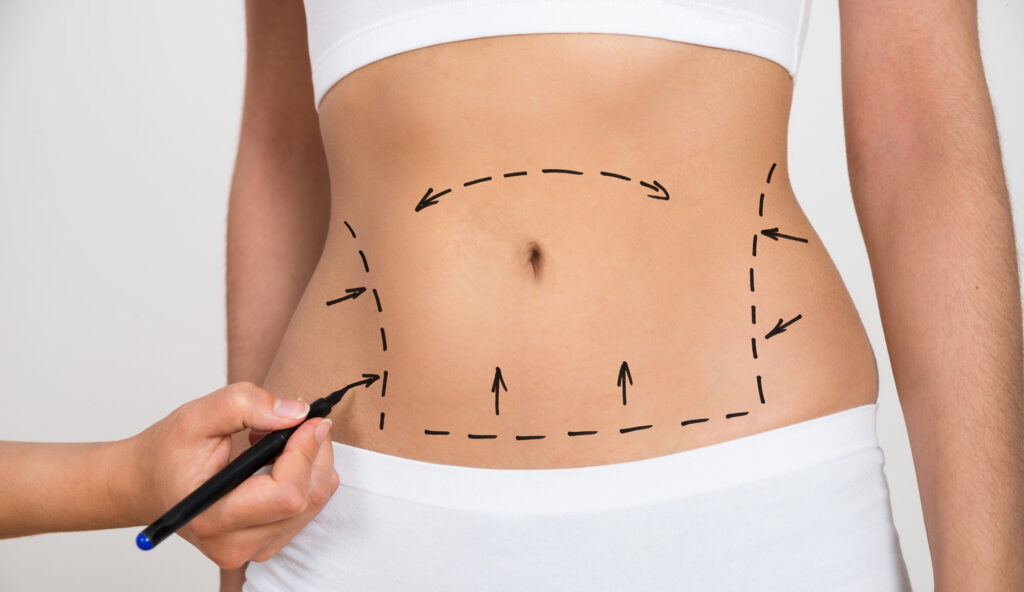Types of Tummy Tucks
Various tummy tuck techniques cater to different needs and body types, allowing a tailored approach based on individual goals.
- Full Tummy Tuck – This traditional method removes skin and fat from both the upper and lower abdomen, also tightening the abdominal muscles. It is suitable for those with significant excess skin and muscle laxity.
- Mini Tummy Tuck – This procedure focuses on the lower abdomen below the belly button, making it ideal for individuals with a small amount of excess skin and muscle laxity. It involves a shorter incision and faster recovery.
- Extended Tummy Tuck – This technique addresses the abdomen and the flanks, making it effective for those with excess skin around the hips and lower back. It’s often chosen after significant weight loss.
Each technique offers unique benefits, and consulting with a plastic surgeon can help determine the option for your needs.
How a Tummy Tuck Works
A tummy tuck involves removing excess skin and fat and tightening the abdominal muscles to create a toned appearance. During the procedure, the surgeon makes an incision along the lower abdomen, typically from hip to hip, to access the underlying muscles. Once the muscles are tightened and repositioned, the skin is stretched, and any excess is removed. The navel is also repositioned for a natural look. The result is a smoother, firmer abdominal profile that restores confidence and comfort for many individuals.
Why Consider a Tummy Tuck?
A tummy tuck can provide both aesthetic and functional benefits, including:
- Improved Abdominal Contour – Achieve a flatter, toned stomach and eliminate loose skin.
- Enhanced Confidence – Many people feel comfortable in fitted clothing and swimwear after a tummy tuck.
- Corrects Muscle Separation – Known as diastasis recti, this condition is common after pregnancy and can be corrected with a tummy tuck.
- Reduces Stretch Marks – If located on excess skin that’s removed, stretch marks may also be eliminated during the procedure.
A tummy tuck is ideal for those seeking a long-lasting, dramatic improvement in their abdominal appearance.
What to Expect During Your Tummy Tuck Consultation
During your initial consultation, the surgeon will evaluate your medical history, lifestyle, and goals to determine the tummy tuck approach. They’ll discuss the potential risks, benefits, and expected results, providing a clear picture of what to anticipate. This is a great time to address any questions you have about the procedure, recovery, or results.
Preparing for Your Tummy Tuck
Preparation is essential for a smooth procedure and recovery. Here are some steps you might take:
- Maintain a Stable Weight – For results, reach a stable weight that you’re comfortable maintaining long-term.
- Avoid Smoking – Smoking can impair healing, so it’s important to stop at least several weeks before and after surgery.
- Adjust Medications – Avoid blood-thinning medications and supplements as advised by your surgeon.
- Prepare Your Home – Set up a comfortable recovery area with easy access to essentials and arrange for help during the first few days.
What Happens During the Procedure
The tummy tuck is performed under general anaesthesia and typically lasts two to three hours. The surgeon makes an incision along the bikini line, lifts the skin, tightens the underlying muscles, and removes any excess skin and fat. Once the new contours are achieved, the skin is repositioned, and the incision is carefully closed to minimise scarring.
Tummy Tuck Aftercare and Recovery
The recovery period varies depending on the type of tummy tuck, but general guidelines include:
- Wear Compression Garments – These garments help reduce swelling and support healing.
- Rest and Take It Easy – Avoid strenuous activities, and focus on allowing your body to recover fully.
- Follow Up with Your Surgeon – Post-operative appointments are crucial to monitor progress and address any concerns.
- Manage Pain and Swelling – Your surgeon may prescribe medication to manage discomfort and inflammation.
Most people can return to light activities within a few weeks, but full recovery may take a few months.
Risks and Side Effects of Tummy Tuck Surgery
While tummy tucks are generally safe, potential side effects include:
- Scarring – Incisions can leave scars, although they fade over time and are usually placed low for discretion.
- Infection or Bleeding – Rare but possible, these risks can be minimised by following your surgeon’s aftercare instructions.
- Seroma Formation – Fluid buildup under the skin is possible, but drains may be used to prevent it.
- Numbness – Temporary numbness near the incision area is common and typically resolves over time.
Choosing a qualified surgeon and closely following aftercare instructions can help minimise these risks.
Non-Surgical Alternatives to a Tummy Tuck
For those who may not be ready for surgery, there are non-surgical options available that can help with mild excess skin and fat:
- CoolSculpting – This procedure freezes fat cells, allowing the body to gradually eliminate them.
- Radiofrequency Skin Tightening – Using radiofrequency energy, this treatment can help tighten loose skin.
- Ultrasound Therapy – Ultrasound energy can target and reduce stubborn fat cells with minimal downtime.
While these treatments won’t provide the same dramatic results as a tummy tuck, they can help improve abdominal contours to a degree.
Functional Benefits of a Tummy Tuck
A tummy tuck can provide functional advantages as well:
- Improved Core Stability – Tightening the abdominal muscles can improve core strength and stability.
- Relief from Back Pain – Some individuals find that better core support reduces strain on the lower back.
- Easier Physical Activity – A flatter, toned abdomen can make activities like exercise and daily tasks easier.
Is a Tummy Tuck Right for You?
A consultation with a board-certified surgeon can help determine if a tummy tuck is suitable for your goals and lifestyle. Whether you’re looking to address post-pregnancy changes, weight loss effects, or simply want a toned abdominal profile, a tummy tuck offers a long-lasting solution for a smoother, defined midsection.




